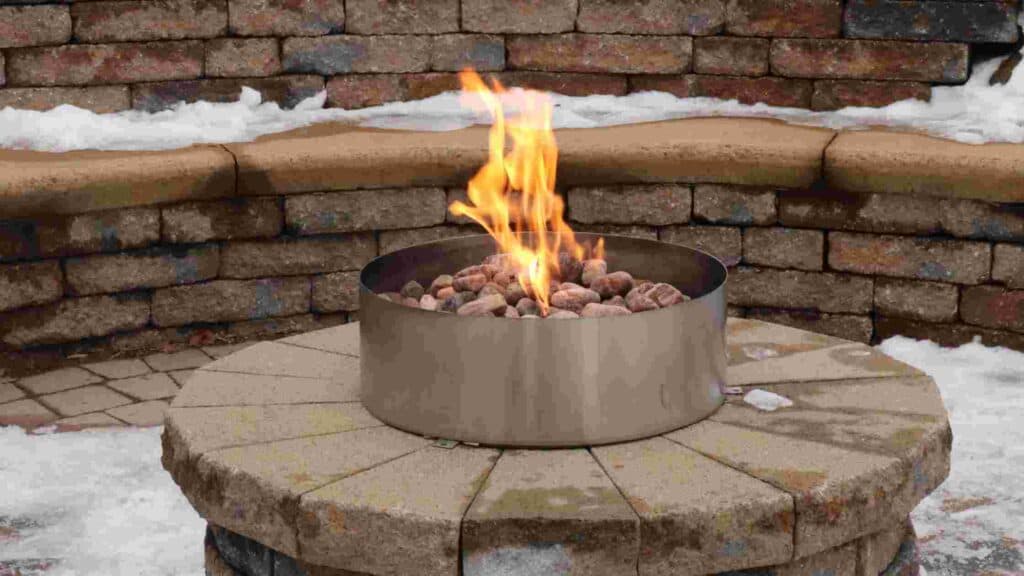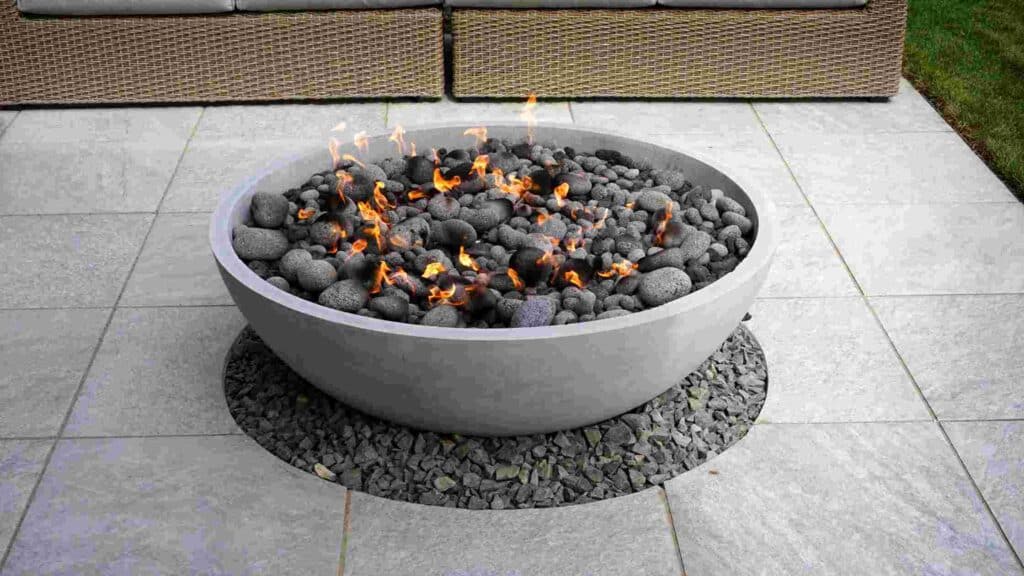Lava rocks, the product of nature’s fiery embrace, hold a unique power to elevate your fire pit experience. These coarse, heat-resistant rocks are formed when volcanic magma cools and releases gases, resulting in their distinctive appearance. In this article, we will delve into the wonders of this product and find out how to use lava rocks for a fire pit setup.
How To Use Lava Rocks For A Fire Pit
The mesmerizing allure of a gas fire pit can be taken to new heights by skillfully arranging lava rocks. Before you embark on this fiery journey, let’s walk through a few essential steps to ensure a seamless experience.
1. Prepare For Perfection
Upon receiving your bag of fire pit rocks, take note that a little dust may have made its way into the bag during the sourcing process. These rocks, meticulously collected from lava fields and tumbled to perfection, deserve a moment of acknowledgment.
2. Lay The Foundation
For a solid base, many fire pit enthusiasts opt to begin with a layer of pea gravel or sand at the bottom of the pit, approximately an inch deep. This provides a stable foundation before the lava rocks make their grand entrance.
How Many Lava Rocks Do I Need For A Fire Pit?
The number of lava rocks required for your fire pit may vary. Refer to the instructions accompanying your fire pit, which will guide you on the optimal amount. Typically, 2 to 4 inches of lava rock is the sweet spot.
3. Start Small, Dream Big
When arranging the first layer of rocks on your gas fire pit, consider using smaller lava rocks. Fill the pit just above the burner element, allowing these petite rock warriors to snugly interlock, forming a sturdy foundation. For those with a touch of extravagance, fire glass can be an alternative layer if the budget permits.
Check out our in-ground fire pit ideas for some inspiration.
4. Measure Twice, Rock Once
Determining the quantity of fire pit rock needed is a crucial task. The shape of your fire pit and the desired depth of lava rock will dictate the amount required. Remember, every fire pit has its own unique appetite for rock perfection.
5. Authenticity Matters
When it comes to gas fire pits, authenticity reigns supreme. Ensure you only utilize genuine lava rock specifically designed for fire pits. Synthetic lava rock intended for planters or gardens should not be used in this fiery realm.
6. Taming The Flames
Once the gas burner is ignited, you have the power to sculpt the flames into an enchanting dance. With a poker in hand, gently maneuver the rocks to achieve the desired shape and aesthetic. Exercise your creative freedom!
7. The Dance Of Fire And Sound
During the first use of your lava rocks, exercise patience and caution. Avoid approaching the fire pit for approximately 30 minutes after ignition. Fresh lava rocks may contain traces of moisture, which need time to dissipate. Listen closely as the rocks emit a rhythmic “popping” sound. Only when this sound subsides, you can fully indulge in the fiery spectacle.
8. Safety First, Always
Remember, wet lava rock should never find its way into your fire pit. Moisture-laden rocks have a knack for unexpected explosions or unruly flights, posing risks to those nearby. Keep your loved ones and furry friends safe by adhering to this golden rule.
9. The Finishing Touch
To add a touch of natural elegance, consider placing ceramic logs atop the vibrant red lava rocks. This creates a picturesque scene reminiscent of a cozy log fire, where the flames delicately flicker and dance around the logs.
Why Use Lava Rock In Fire Pit?

With their rustic allure, lava rocks have gained immense popularity as a preferred option for both outdoor and indoor gas fire pits (learn how to light a gas fire pit). Unlike sandstone, river rocks, natural rocks, or gravel, which are prone to cracking or even exploding under intense heat, lava rocks offer a safer alternative. Let’s explore their advantages in more detail:
1. Weatherproof Shield
Introducing a layer of lava rocks (approximately 3 to 4 inches) in your fire pit offers a protective shield for the burner, regardless of the weather conditions. As lava rocks are naturally water-resistant, they aid in channeling water toward your fire pit’s drainage system, safeguarding the burner from moisture-related damage.
2. Heat Resistant Rocks For Fire Pit
Lava rocks possess an exceptional ability to evenly distribute heat over an extended period. When placed in a gas fire pit, they ensure consistent and long-lasting warmth without any bothersome cold spots. Prepare to bask in the cozy embrace of radiant heat!
3. Durability
Originating from volcanic eruptions, lava rocks exhibit an unrivaled resilience to scorching temperatures, remaining steadfast without crumbling or succumbing to damage. Requiring minimal upkeep, they stand the test of time, making them a long-lasting investment for your fire pit. Additionally, lava rocks are eco-friendly, lightweight, free from additives or chemicals, and maintain their vibrant color over extended use. Plus, they won’t burn a hole in your pocket!
4. Safeguard Your Burner
When you ignite your gas fire pit, the flames dance through the gaps between the lava rocks, creating a mesmerizing display. These rocks act as guardians, shielding the burner from the extreme heat that gathers at the top of the fire pit. With their great insulating properties, lava rocks enhance the burner’s performance and prolong its lifespan. It’s a win-win situation!
Exposure To Sunshine
If your fire pit, adorned with lava rocks, basks in the sun for prolonged periods, it is wise to shield it from the sun’s relentless rays when not in use. A cover can help preserve the rocks’ integrity and protect them from unnecessary exposure. It’s a simple step that ensures your fire pit remains in pristine condition.
Best Lava Rocks For Gas Fire Pit
After exploring the merits of lava rock as an excellent option for gas fire pits and considering alternative choices, it’s time to delve into our top picks of lava rocks to elevate your fire pit experience. Brace yourself for the ultimate fire pit transformation!
1. Dragon Glass Lava Pebbles: Nature’s Splendor
These exquisite lava pebbles, sourced from Asia, exude a captivating charm with their elegant gray, oval appearance. Surprisingly budget-friendly, these lava pebbles are packaged in 20-pound bags. Tailor your purchase by opting for a single bag, or go big with a selection of 2, 3, or even 4 bags (a total of 80 pounds of rock), ensuring you have ample supply.
Features:
- Strong and durable, perfect for gas fire pits
- Stunning visual appeal with a beautiful gray, oval shape
- Offers affordability with packs ranging from 20 to 80 pounds
- Sourced from natural origins
2. Venetian Princess Lava Rocks: Rustic Elegance
With a multitude of glowing reviews, Venetian Princess Lava Rocks emerge as a standout choice for gas fire pit enthusiasts. Available in a pack of 10 pounds, this lava rock option offers affordability, priced under $20. For those with expansive properties or larger fire pits, a 40-pound bag is also available.
Customize your fire pit’s aesthetics by choosing between rustic red or sleek black lava rocks, ensuring seamless integration with your outdoor decor.
Features:
- Available in rustic red or black hues
- Available in 10 and 40-pound options, catering to your specific requirements
- Affordable pricing for quality lava rock
- Earned numerous positive reviews
Fire Pit Safety: Prioritizing Peace Of Mind

While fire pits bring forth ambiance and beauty to your outdoor space, safety should always be a top priority.
To ensure a safe and enjoyable fire pit experience, remember these key points:
- Use safety gloves when handling your fire pit.
- Keep a functional fire extinguisher nearby at all times.
- Read and follow the instructions provided in the fire pit manual.
- Familiarize yourself with local regulations regarding fire pit usage (you may also be interested in the article: Can you have a fire in your backyard?).
- Never leave the fire unattended and keep children away from the fire pit.
- Avoid using the fire pit on excessively windy days.
- Place the fire pit at a safe distance from structures, overhanging branches, power cables, or any potential fire hazards (find out how far should a fire pit be from a house). Adequate ventilation is crucial.
- Completely extinguish the fire when finished using the fire pit.
- Use recommended fire starters and begin with a small flame size (check out how to start a fire in a fire pit).
- Regularly clean up debris around the fire pit.
- If you detect the smell of gas near the fire pit, refrain from using it. Check for gas leaks, and if unable to shut off the leak, contact the gas company or fire department immediately.
- If available, cover the fire pit with a lid once the fire is out.
- Clean the fire pit and its burners regularly to prevent blockages.
- Keep flammable objects away from the fire pit.
Fire safety remains paramount, particularly when children and pets are present or if you are new to managing fires. Take extra precautions to prevent accidental injuries or hazards.
Lava Rock Alternatives
While lava rock holds undeniable advantages, it may not suit everyone’s aesthetic preferences. Some find its rustic allure a bit too raw for their liking. If you yearn for a broader spectrum of colors and sizes, fear not, for there are alternative options available to fuel your fire pit fantasies.
1. Tumbled Lava Rock: Smooth Transitions
For a lava rock alternative that preserves the essence of its volcanic origin while offering a smoother appearance, consider tumbled lava rock. These rocks have undergone a process that removes rough edges, resulting in rounded and uniform shapes. Use them as a base if desired or fill your fire pit entirely with these transformed treasures.
2. Fire Glass: Igniting Brilliance
Fire glass, despite its name, is not your ordinary glass. Ordinary glass would succumb to the fiery inferno of a fire pit, whereas fire glass has undergone a tempering process, rendering it fire-safe and heat-resistant. These dazzling crystals neither burn, melt nor lose their vibrant hues. Embrace the shimmering spectacle!
Fire pit glass beads, with their polished surfaces and sparkly demeanor, offer a striking departure from the coarse texture of lava rock. Prepare to witness an intensified fire display, with flames flickering, shimmering, and illuminating even the darkest nights. An undeniable atmosphere envelopes your outdoor haven. Fire glass beads, typically smaller than lava rock, boast a consistent shape, allowing for the even dispersion of heat.
Once heated, fire glass transforms into a radiant source of intense warmth, courtesy of its reflective nature. Like its volcanic counterpart, fire glass excels as a heat conductor.
Available in a myriad of sizes and colors, fire pit glass grants you the freedom to mix and match, unleashing your artistic spirit. The classic mound shape, slightly elevated in the center, is the preferred arrangement for fire glass in your outdoor fire pit.
Maximizing The Impact
For those seeking a harmonious blend, layering fire glass on top of existing lava rock proves to be an ideal solution. This approach not only ensures efficient heat distribution and enhanced protection for key fire pit components but also widens the spectrum of design possibilities. Aim for approximately 20-25% fire glass coverage if you choose this layered masterpiece.
Should you opt for fire glass as the top layer, with lava rock as the foundation, generously scatter the fire glass to create a visual effect that veils the lava rock beneath. Darker-colored fire glass works wonders in achieving this harmonious camouflage.
While fire glass boasts longevity, its sparkle may fade over time, and occasional chipping can occur. Be mindful that fire glass is more prone to showing dirt and soot compared to lava rock. Regular cleaning of the fire glass beads becomes necessary. Remove the beads, give them a thorough wash (dish soap works wonders), rinse, and dry them meticulously. This cleansing ritual also presents an opportunity to rid your fire pit of debris and clean the burner pan.
3. Dirt: Simplicity With Caveats
Dirt, a surprisingly inexpensive and heat-resistant choice, offers easy installation for your fire pit. Yet, its drawbacks are worth noting. Ash from your fire may intermingle with the dirt, resulting in an arduous cleaning process, especially when moisture enters the equation. In such cases, shoveling out and replacing the dirt becomes a necessary routine. Opting for dirt as your fire pit filling requires a relatively high level of maintenance.
4. Sand: Cost-Effective
Sand presents itself as another viable option for filling your gas fire pit. It can be used in combination with fire glass and/or lava rock or utilized independently. Although it may lack the visual charm of its counterparts, sand proves to be a cost-effective solution for budget-conscious fire pit enthusiasts. Its heat distribution capabilities should not be underestimated. However, be cautious of ash mingling with the sand, potentially creating a messy scenario that requires replacement, particularly if it becomes wet.
FAQs – How To Put Lava Rocks In Fire Pit
1. How to place lava rocks in propane fire pit?
To place lava rocks in a propane fire pit, ensure the burner is turned off and the fire pit has cooled down. Then, carefully arrange the lava rocks on top of the burner, covering it evenly to create a stable and decorative base.
You may also be interested in: Can you roast marshmallows on a propane fire pit?
2. Should fire glass cover the burner?
Fire glass is typically not used to cover the burner in a propane fire pit. Fire glass is often placed on top of the lava rocks to enhance the aesthetic appearance and provide additional heat reflection.
3. How to use a metal fire pit?
To use a metal fire pit, place it on a fireproof surface, away from flammable materials. Add firewood or fuel to the pit, ignite it using appropriate methods, and enjoy the warmth and ambiance. Follow safety guidelines and extinguish the fire properly after use.
4. Why do you put rocks in the bottom of a fire pit?
Rocks are placed in the bottom of a fire pit to help with drainage and heat distribution. They act as a barrier between the ground and the fire, reducing the risk of heat damage to the underlying surface.
5 How to put lava rocks in gas fire pit?
To put lava rocks in a gas fire pit, follow the manufacturer’s instructions. Typically, you would remove the burner cover, arrange the lava rocks evenly on top of the burner, and ensure they cover the burner holes without obstructing gas flow.
6. How to use lava rocks for a wood fire pit?
Lava rocks can be used in a wood fire pit as a heat barrier and to help retain and distribute heat. Place them in the bottom of the fire pit, forming a layer, and stack firewood on top to create a stable and efficient fire.
You may also be interested in checking out how to make a bonfire pit.
7. What is the best rock for a wood-burning fire pit?
The best rock for a wood-burning fire pit is typically fire-resistant natural stone, such as granite, sandstone, or river rock. These rocks can withstand high temperatures without cracking or exploding, ensuring safe and long-lasting use in a wood-burning fire pit.
Conclusion: Can You Use Lava Rock In A Fire Pit?
In the realm of fire pits, lava rocks hold distinct advantages over other decorative options for gas fire pits. Derived from volcanic origins, lava rocks boast remarkable heat tolerance, making them an ideal choice for fire pits, particularly those fueled by gas. In addition to providing an aesthetic appeal, a layer of lava rocks acts as a protective barrier for the fire pit’s essential components.
Embrace the safety, rustic charm, and versatility that lava rocks offer as a decorative choice for gas fire pits. We sincerely hope that our guide on using lava rocks for fire pits has shed light on the incredible possibilities that lie before you. Let the fiery dance begin!
You might also be interested in checking out the best fire pit cooking grates.
